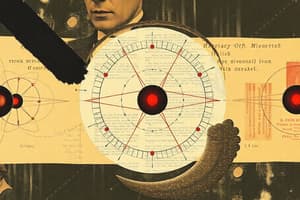Podcast
Questions and Answers
What is the charge of the up quark?
What is the charge of the up quark?
- 0
- +1/2
- -1/3
- +2/3 (correct)
Protons consist of two down quarks and one up quark.
Protons consist of two down quarks and one up quark.
False (B)
What role do neutrons play in the atomic nucleus?
What role do neutrons play in the atomic nucleus?
They prevent the nucleus from coming apart due to repulsive forces between protons.
The neutron consists of two ______ quarks and one up quark.
The neutron consists of two ______ quarks and one up quark.
Match the following particles with their charges:
Match the following particles with their charges:
Which of the following particles has a net charge of zero?
Which of the following particles has a net charge of zero?
Quarks are not considered fundamental particles in physics.
Quarks are not considered fundamental particles in physics.
Name the six varieties of quarks.
Name the six varieties of quarks.
What is the main focus of the physics course taught by Prof.Dr. E.F. Abo Zeid?
What is the main focus of the physics course taught by Prof.Dr. E.F. Abo Zeid?
The final exam constitutes 30% of the overall grade in the course.
The final exam constitutes 30% of the overall grade in the course.
What is the primary textbook used for this physics course?
What is the primary textbook used for this physics course?
The course is scheduled for Saturdays from _____ to _____ AM.
The course is scheduled for Saturdays from _____ to _____ AM.
Match the following evaluations with their respective percentage contributions to the overall grade:
Match the following evaluations with their respective percentage contributions to the overall grade:
Why is studying physics considered important?
Why is studying physics considered important?
Cellphones are allowed to disturb lectures as long as they are turned to silent mode.
Cellphones are allowed to disturb lectures as long as they are turned to silent mode.
What are students required to do prior to exams according to the course policy?
What are students required to do prior to exams according to the course policy?
What is the average velocity of a particle moving according to the equation x = 10t^2 for the time interval from 2.00 s to 3.00 s?
What is the average velocity of a particle moving according to the equation x = 10t^2 for the time interval from 2.00 s to 3.00 s?
A particle's speed increases as it moves in the negative direction when uniformly accelerated.
A particle's speed increases as it moves in the negative direction when uniformly accelerated.
What is the acceleration of an object with an initial velocity of 12.0 cm/s if its position changes from 3.00 cm to -5.00 cm in 2.00 s?
What is the acceleration of an object with an initial velocity of 12.0 cm/s if its position changes from 3.00 cm to -5.00 cm in 2.00 s?
The position equation of a particle is given by x = 2 + 3t - 4t^2. The particle changes direction when t = ______ seconds.
The position equation of a particle is given by x = 2 + 3t - 4t^2. The particle changes direction when t = ______ seconds.
Match the following mechanics concepts with their definitions:
Match the following mechanics concepts with their definitions:
In vector analysis, which of the following is true about vector addition?
In vector analysis, which of the following is true about vector addition?
The scalar quantity associated with wave energy is momentum.
The scalar quantity associated with wave energy is momentum.
What is the primary characteristic of light as described in wave dynamics?
What is the primary characteristic of light as described in wave dynamics?
Flashcards
Nucleus Stability
Nucleus Stability
Neutrons prevent the nucleus from breaking apart due to the repulsive forces between positively charged protons.
Proton Composition
Proton Composition
A proton is made of two 'up' quarks and one 'down' quark.
Neutron Composition
Neutron Composition
A neutron is made of two 'down' quarks and one 'up' quark.
Quark Charges
Quark Charges
Signup and view all the flashcards
'Up' Quark Charge
'Up' Quark Charge
Signup and view all the flashcards
'Down' Quark Charge
'Down' Quark Charge
Signup and view all the flashcards
Repulsive Force in Nucleus
Repulsive Force in Nucleus
Signup and view all the flashcards
Quark Types
Quark Types
Signup and view all the flashcards
Physics Course Schedule
Physics Course Schedule
Signup and view all the flashcards
Instructor's Office Hours
Instructor's Office Hours
Signup and view all the flashcards
Midterm Exam Weight
Midterm Exam Weight
Signup and view all the flashcards
Final Exam Weight
Final Exam Weight
Signup and view all the flashcards
Textbook for Physics
Textbook for Physics
Signup and view all the flashcards
Late Submissions Policy
Late Submissions Policy
Signup and view all the flashcards
Course Objective
Course Objective
Signup and view all the flashcards
Cell Phone Policy
Cell Phone Policy
Signup and view all the flashcards
Average Velocity
Average Velocity
Signup and view all the flashcards
Displacement
Displacement
Signup and view all the flashcards
Position Equation
Position Equation
Signup and view all the flashcards
Motion in One Dimension
Motion in One Dimension
Signup and view all the flashcards
Scalar Quantity
Scalar Quantity
Signup and view all the flashcards
Vector Quantity
Vector Quantity
Signup and view all the flashcards
Unit Vector
Unit Vector
Signup and view all the flashcards
Vector Components
Vector Components
Signup and view all the flashcards
Study Notes
Course Information
- Course Title: Physics for Computer and Artificial Intelligence
- Instructor: Prof. Dr. Essam Fadl Abo Zeid
- Course Code: (Not provided)
- Schedule: Saturdays, 9:00 AM - 11:00 AM
- Office: 4th floor, Artificial and intelligence Building, Physics Department, Faculty of Science, Assiut University
- Office Hours: Saturdays, during the lecture
- Email: [email protected], [email protected]
- Textbook:
- Physics for Scientists and Engineers with Modern Physics by Serway and Jewett (8th edition, 2011)
- Physics by G. Rowell & S. Herbert (4th edition, 2005)
- Other readings may be announced
- Lecture Notes: Provided
- Midterm Exam: November 2024 (Details to be announced)
- Grading:
- Midterm Exam (20%)
- Practical Exam (20%)
- Assignments (10%)
- Final Exam (50%)
- Policy:
- Attend lectures and lab sessions on time.
- Late work will not be accepted.
- Attend exams on scheduled dates and times.
- Notify instructor of any missed exams in advance.
- Cellphones must be turned off during lectures.
- Follow university regulations regarding cheating and plagiarism.
- Handle university facilities carefully
- Pre-read assigned material to ensure student success.
Course Content
- Chapter 1: Physical Quantity, Units, and Dimensions (1 week)
- Chapter 2: Motion in one Dimension (2 weeks)
- Chapter 3: Vector Analysis (2 weeks)
- Chapter 4: Waves, Oscillations and Sound (2 weeks)
- Chapter 5: Light lenses and mirrors (2 weeks)
- Chapter 6: Heat and Thermodynamics (2 weeks)
- Chapter 7: Electricity & Magnetism (2 weeks)
Chapter 1: Physical Quantity, Units and Dimensions
- Topics:
- Standards of length, mass, and time
- Density and atomic mass
- Dimensional Analysis
- Conversion of units
- Basic Quantities: Length (L), Mass (M), Time (T)
- Standards: Meter (length), Kilogram (mass), Second (time)
- SI Units: A system of units based on the above
- CGS Units: A system of units used in historical contexts
- Other Systems: Includes British Engineering System
- Density: Mass per unit volume
- Calculation Example (Aluminum and Lead)
- Atomic mass (Mole concept): The mole and Avogadro's number
- Calculation example using Aluminum and Lead
Chapter 2: Motion in One Dimension
- Topics:
- Position, Velocity and Speed
- Instantaneous Velocity and Speed
- Acceleration
- One-dimensional motion with constant acceleration
- Vector analysis
Chapter 3: Vector Analysis
- Topics: Coordinate Systems (Cartesian and Polar)
- Vector quantities: Have magnitude and direction
- Scalar quantities: Have magnitude but no direction
- Vector Addition: Triangle method, Parallelogram method, Polygon method.
- Vector Subtraction:
- Vector Multiplication by a scalar
- Vector components
- Unit Vectors: î, ĵ, k
Studying That Suits You
Use AI to generate personalized quizzes and flashcards to suit your learning preferences.




